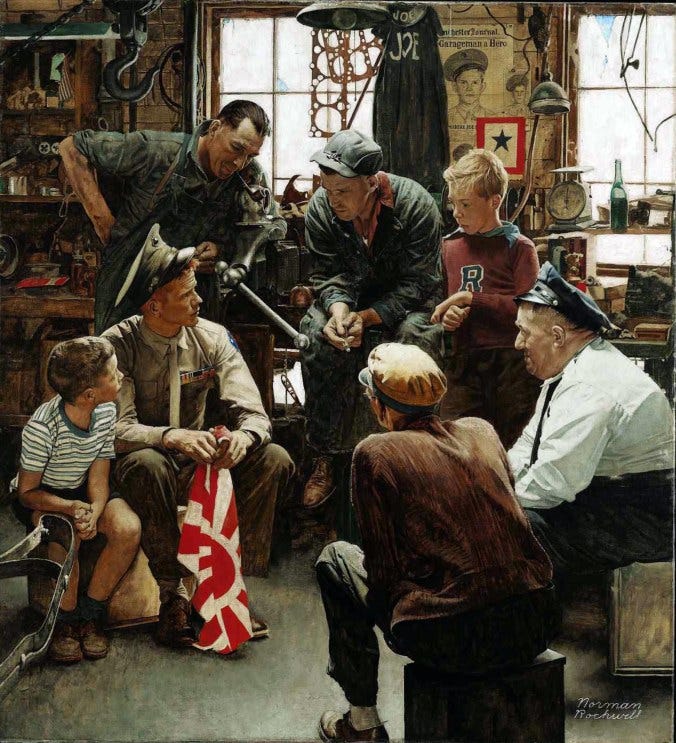
The Homecoming Marine (1945)
To grasp the genius of this painting, one must resist the temptation to approach it with preconceived ideas about the Second World War. Rather than beginning with what we know about Marines in the Pacific theater, we must ask: What does Rockwell choose to show us? What reality does he judge essential?
A painter is not a photographer. He is not bound to depict whatever is captured in a single frame of happenstance. He selects, arranges, and idealizes. In The Homecoming Marine, every element is deliberate—each figure, each expression, each object—chosen to communicate a fundamental truth about the man at its focus, and about the culture receiving him. Rockwell doesn’t show us what war was. He shows us what kind of man emerges from it—and what that man means to those back home.
The scene is a mechanic’s garage. Inside, two boys and four adult men gather around a young Marine in a khaki uniform. The Marine wears combat ribbons on his chest, including the Silver Star—America’s third-highest decoration for valor. His cap is cocked back with casual individuality, and in his hands he holds a red and white Japanese flag. It is not a souvenir; it is a symbol, and he grips it firmly, but not possessively. His body is strong, his presence unmistakable—yet he neither speaks nor returns the eager gazes of those around him. His eyes are turned away, his expression somber, almost haunted. He is not aloof, but inward, wrestling with something unresolved.
The boys flanking him reflect two facets of admiration. One, seated close by, is tightly wound, hands clenched in rapt tension. The other leans against a workbench in an unconscious contrapposto, eyes wide with unfiltered awe. Behind the Marine, a worn mechanic, cigarette nearly burned to ash in his hand, speaks gently. His mouth is open just enough to form words, but not loud ones. His manner says: I understand. Another man stands with a pipe in his mouth, smiling softly, with pride in his eyes. Two older men complete the circle: one uniformed, stout, and official; the other, frail and hunched, leaning forward to catch a closer look. Each man radiates interest, reverence, and some mix of recognition and wonder.
On the wall behind them hangs a newspaper clipping. It identifies the Marine as both a garage worker and a war hero—a civilian transformed by service, not a career warrior. A duplicate photo tacked beside it suggests this man was known to them before the war, and honored since. A blue star on a service flag affirms his intimate connection to the shop. He may not be their literal son, but he is their own.
This is not the triumphant homecoming of propaganda. This is not the ecstatic embrace of Times Square. Rockwell gives us something harder and more valuable: a meditation on quiet heroism and earned reverence. The Marine has returned from horrors most men will never know. He carries no bitterness, no boast—but also no ease. His readjustment will not be instant. And yet, he is surrounded by those who see him—who do not look away, who do not speak over him, who do not try to reduce him to something manageable. They know he is different now, and they honor the difference.
Rockwell’s choices reflect something uniquely American: a culture that reveres the citizen-soldier. These men are not celebrating an abstraction. They are looking at their Marine—the man who fixed their cars, who now stands before them having faced death in defense of their world. They do not turn him into a myth. They let him remain a man.
When one considers the historical record—the brutality of the Pacific War, the ordinary backgrounds of most who fought it, the psychological burdens they carried—Rockwell’s depiction becomes even more powerful. It’s difficult to imagine a Soviet version of this scene, where the temptation to inject ideology would overpower the reality of the individual. But Rockwell resists that urge. He doesn’t use the Marine to glorify the state. He shows him as a human being shaped by a terrible crucible—and welcomed home not with slogans, but with solemn respect.
Though Rockwell is often derided for painting everyday life, there is nothing merely “everyday” about this man. He has endured something extraordinary. He bears it with dignity. And in his silence, he invites reflection from everyone around him—viewers included.
The Homecoming Marine is a masterpiece of American moral realism. Rockwell doesn’t sentimentalize the veteran. He honors him. He shows the cost of war, the weight of service, and the gaze of a community that understands both. This man is their champion. And they do not turn away. For those of us who admire Rockwell’s work—neither do we.
Series Index
Part I: The Scoutmaster
Upcoming:
Part III: Lincoln the Railsplitter
Part IV: The Problem We All Live With
Part V: Freedom of Speech

Join us for an exclusive online event for ARI donors on June 7.
The post A Conversation with Zol Cendes, Electrical Design Entrepreneur appeared first on New Ideal - Reason | Individualism | Capitalism.


A collection of nine timely and timeless philosophical essays, now available for purchase.
The post Announcing <em>Ayn Rand’s Philosophic Achievement and Other Essays</em>: A New Book by Harry Binswanger appeared first on New Ideal - Reason | Individualism | Capitalism.




